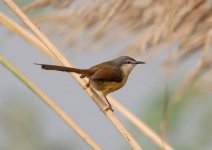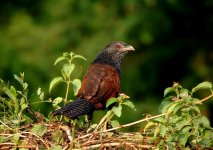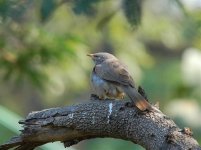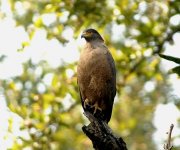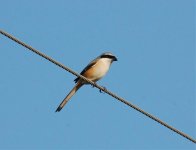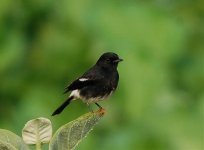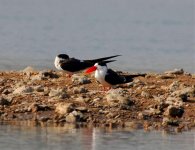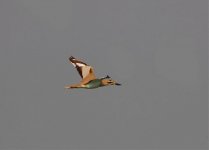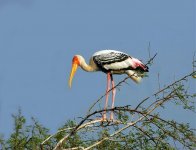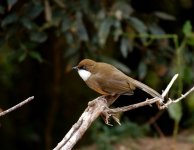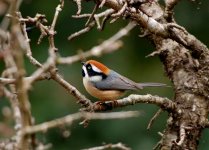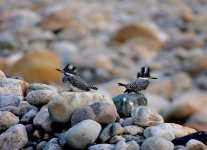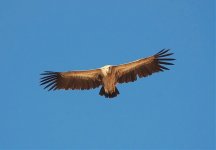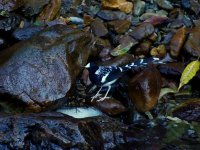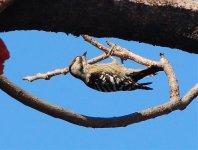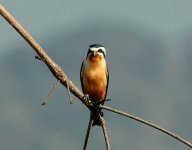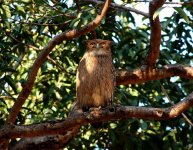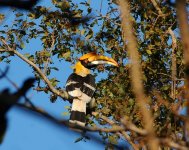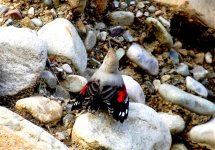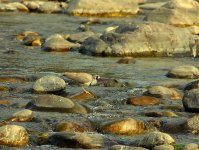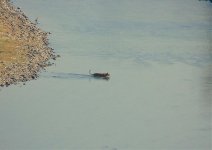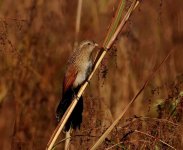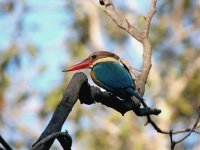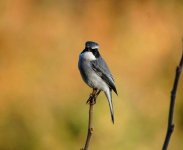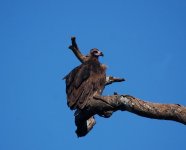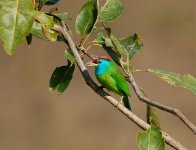Cuckoo-shrike
Well-known member
NORTHERN INDIA : Nov 15th – Dec 9th 2008
Andy and Helen Pay
We arranged this trip through Asian Adventures (http://www.indianwildlife.com/), taking one of their standard itineraries and making a few minor changes. The main targets of the trip were tigers, lots of birds and some cultural experiences. Our itinerary was Delhi, Kanha National Park, Agra, Chambal, Bharatpur, Pangot and Sattal, Corbett National Park.
We flew from Heathrow to Delhi with Virgin Atlantic, arriving at midday on Nov 15th and were met by a representative of the company and transferred by taxi to our hotel in the city. After a meal in a local restaurant, we went to bed early and slept for about 12 hours.
Nov 16th (day 1)
Sitting on the hotel roof eating breakfast, it was becoming apparent that our decision to have an extra couple of days in Delhi was a mistake. The smog reduced visibility to a few hundred metres and our throats and lungs were already complaining about the poor air quality. Although it was good to see several Black Kites floating around, it was of course the filth and squalor which was attracting them. Rose-ringed Parakeets were screaming around and House Crows were hopping about on the tables.
We hired an auto-rickshaw driver for a tour of some of the sights and found the experience quite exhilarating. Anarchy rules on Indian roads. Every vehicle bears numerous dents and scratches and constant blasting on the horn is obligatory. Cows and stray dogs wander across the carriageways with impunity, even in the city centre. We visited Indian Gate and the adjacent parks (where Helen was hit by a cricket ball from one of the numerous games going on!), saw some Red-vented Bulbuls, Five-striped Palm Squirrels and Rhesus Macaques and then had a decent meal in a restaurant off Connaught Place. It was already clear that we would be eating plenty of rice and dahl in the forthcoming weeks. On the way back, our driver was very insistent that we should visit a shopping mall. Of course he gets commission for every shopper he delivers through their doors. We went in like lambs to the slaughter and almost inevitably ended up spending quite a lot of rupees on some paintings, a silk scarf, pashmina and hand-crafted silver goblets, bottle and tray.
Nov 17th (day 2)
This morning we were driven to the Okhla Bird Sanctuary, a strip of bushes and scrub alongside the Yamuna River on the outskirts of the city. Although there were clearly some new birds to be had, the murky conditions and the noise from adjoining construction work were not conducive to enjoyable birding. We spent the morning ambling from one end to the other in a kind of jet-lag and pollution-induced stupor. There were large numbers of wildfowl way out on the river but I had inexplicably left my ‘scope at the hotel. There were some Spot-billed Ducks within binocular range however and we also saw our first Brown-headed Gull. The marshy riverbank had Indian Pond Heron and Purple Swamphen and the first of what was to be many White-throated Kingfishers. We found Ashy and Grey Prinias in the bushes, along with Long-tailed Shrike, Common Tailorbird, Red-whiskered Bulbul, Indian Silverbill and a female Purple Sunbird. A Rufous Treepie swooped from one tree to the next and Green Bee-eaters used the branches as look-out perches. Asian Pied Starling, Hoopoe and House Swift completed a modest but satisfactory first-day list, before the sight of a local chap squatting to do his business on the path ahead signalled that it was time to retrace our steps. With hindsight, we probably missed a few easy species today.
In the afternoon we had a guided tour of some of Delhi’s landmarks. The Red Fort dates from the peak of Mughal power in northern India and was completed in 1648. Its walls extend for 2 km and are up to 33 metres high. Humayan’s Tomb, built in the mid 16th Century, is an example of early Mughal architecture. Elements in its design were to be refined over the years to eventually create the Taj Mahal. Nearby is the Isa Khan Tomb Enclosure, dating from 1547. Finally, we stopped for a look at the Rashtrapati Bhavan (Presidential Palace) before heading back to the hotel for an early night before our flight south the next day.
Nov 18th (day 3)
We had chosen Kanha National Park in Madhya Pradesh, 500 miles south-east of Delhi, for tigers, as sightings there are pretty well guaranteed. We went there first to see a tiger so that we could then relax! The Park stretches over an area of 940 km² with a surrounding buffer zone of 1009 km².
Any hopes of getting a refreshing night’s sleep ready for our early morning flight to Jabalpur were dashed by the builders on the site right next to the hotel working late into the night. We were up at 4.00am but as it happened the flight was delayed a couple of hours and we finally arrived at Jabalpur at 12.45pm. We were met by our driver and set off for the 100 mile drive to Krishna Jungle Resort, just outside Kanha. The flat and dusty plains gradually gave way to higher ground as we sped through the countryside and villages, horn blazing almost continuously.
We arrived at the small and very tasteful complex at 4.00pm and were shown to a first floor apartment. It was a great relief to breathe clean air and, for the first time since arriving in India, we felt relaxed. The evening meal was held in front of a bonfire where, along with some British visitors on a Saga holiday (!), we were entertained by some terrific local musicians and dancers.
Nov 19th (day 4)
We had pre-booked a number of safaris into the park and we were out before dawn at 5.30am. We climbed into our Gypsy (small safari jeep manufactured by Maruti Suzuki) with our driver and young guide Sudhir Singh and drove the few miles to the park entrance. Here we joined a short queue of other Gypsies waiting for the gates to open at 6.00am. Everything is geared up to finding tigers. The Gypsies charge around hoping to find one on the dirt roads and occasionally stopping to listen out for alarm calls, especially of monkeys and Spotted Deer. Meanwhile, the mahouts head off into the forest on their elephants ready to report any tigers they find.
We were asked if we wanted to drive hard through the park to perhaps find our own tiger but we opted for a more leisurely approach to look at birds and other wildlife. Amongst the commoner birds were Black and Greater Racket-tailed Drongos, Indian Peafowl, Alexandrine Parakeet, Greater Coucal and frequent flocks of noisy Jungle Babblers. We also saw Black-shouldered Kite, Crested Serpent Eagle, Shikra, Jungle Owlet and Black-rumped Flameback. As for mammals, Spotted Deer were numerous, with a few Sambhar deer, Gaur (Indian Bison, the largest species of cattle in the world), Wild Boar and four Golden Jackals.
Mid-morning a message came through that a feeding tiger had been located and we drove over to be number three in the queue to take an elephant ride to see it. Our turn soon came around and within a few minutes we were looking down at a huge male tiger tucking into the stinking carcass of a male Gaur. It didn’t seem too worried by our presence but it did start to drag the dead animal further into cover, demonstrating its immense strength. After a few photos it was back out to allow the next punters to take their turn. It was a fantastic experience, in spite of the fact that it was felt like being on a twitch!
After lunch we returned to the park for another cruise round. Unfortunately the guides weren’t very interested in the small, less spectacular birds and their i.d. skills were very limited. For example, a distant flock of “Scarlet Minivets” were on closer inspection clearly Long-tailed Minivets. On the drive back to Krishna and later that night, we had the only rain of the entire trip.
Nov 20th (day 5)
Helen was down with a cold today (probably exacerbated by the after-effects of Delhi smog), so I did the morning safari without her. There were no tiger sightings so she wasn’t too miffed, but I did get a few new birds. We spent a long time manoueving the vehicle (getting out is forbidden) to get good views of a White-rumped Shama skulking around under the bushes and I established that a couple of the calls I was hearing frequently were Greenish and Hume’s Warblers. Also amongst the new species were the bizarre Crested Tree-swift, White-rumped Vulture, the first Indian Roller of the trip and a water snake swimming across a pond.
In the afternoon I had a bimble around the vicinity of the camp instead of doing the safari. The local village folk stared a lot, understandably, but usually returned a smile. Down the lane behind the camp I had a nice pair of Blue-winged Leafbirds and our first Taiga Flycatcher.
Nov 21st (day 6)
Helen decided to give the morning a miss, wisely as the early ride on the back of the Gypsy is very bracing. Our driver was in a competitive mood today. He gained fifth place in the queue, from eighth, by some nifty overtaking whilst other drivers were half asleep, then swept into second place whilst the three in front paused to photograph a Gaur. By taking the first turn to the left we had an open road ahead of us and we spent the next hour bouncing around on the bumpy tracks as he drove hard into the heart of the forest. Although it was quite exhilarating, I was beginning to wonder just what it was all about, especially as I was hearing some amazing bird calls and getting fleeting glimpses of new species as we whizzed by. These tactics, aimed at finding a tiger before anyone else, failed to pay off as we actually saw very little.
Helen was back for the more sedate afternoon drive and brought us luck as we saw a male tiger making its way slowly through some long grass. Shortly afterwards we had a real bonus in the shape of a Sloth Bear – rarely seen in the winter – ambling about by some rocks before gambolling off into the trees. We also nearly ran over a Cobra which crossed the track right behind us and saw more Jackals, Gaur, Sambhar and lots of Spotted Deer.
Some super new birds today – including Bay-backed and Rufous-tailed Shrikes, Malabar Pied Hornbill, Blue-throated Flycather, Grey-headed Canary-flycatcher and an Olive-backed Pipit - took the total to a modest 80 so far.
Nov 22nd (day 7)
Our last morning safari produced two female tigers and a rare Swamp Deer or Barasingha. The first tiger was at close range from elephant-back, a dozing individual semi-hidden in vegetation, but the second was more exciting. Given a tip-off by a Gypsy-driver coming in the opposite direction, our man did a quick U-turn and sped off in pursuit. Walking sedately along the road ahead was a rather skinny-looking tigress. Ahead of her were several more Gypsies reversing steadily to maintain a suitable distance. After a couple of minutes she turned off on to a track on the left which was marked out of bounds by a small log placed across it and we watched her disappear around the corner.
The other vehicles pulled away but we noticed that our driver and guides were having an earnest discussion (in Hindi of course). Then, glancing up and down the road to make sure the coast was clear, our man swung our vehicle around, bounced over the log and set off after the tiger. We soon caught her up and had a few minutes following from at a respectful range, allowing me to take some more photos as she crossed a stream (though she hardly turned round). Then we went back up to the main track, our companions giggling away, at which point Sudhir kindly informed us that this was the tigress which had killed an elephant-keeper two months back and had also leapt on to the bonnet of a ranger’s land-rover!
The afternoon drive was quiet by comparison, apart from a snake alongside the access road.
Nov 23rd (day 8)
I spent the last couple of hours at Krishna birding along the lane with Sudhir. We made our way down to the river and saw Blyth’s Reed Warbler, Tickell’s Blue Flycatcher and Golden-fronted Leafbird. Before Helen and I left the camp, we experienced joy and disappointment in quick succession. Presented with our bill, we were thrilled to find that the sum we were expecting to pay for the safaris and guide fees had apparently been included in the figure we had paid to the agents on arrival in Delhi. We were on the point of departure when a breathless employee caught us up and gave us the bad news.
23,000 rupees poorer we set off for Jabalpur at 10.30am. On arrival our driver dropped us at the Hotel Krishna for lunch and we also picked up a huge take-away for our evening meal. Then we were driven to the railway station for our overnight sleeper to Agra. An aging porter engaged by the driver insisted on carrying both of our large, heavy bags one on top of the other on his head! As he creaked up the steps and over the bridge, we fully expected his knees to buckle and our luggage to go crashing to the ground, but he just about managed the task and deserved the good tip we gave him.
The train left at 3.55pm and within a couple of hours it was dark outside. Just as we opened our boxes of food a mouse suddenly shot behind our luggage. He didn’t reappear and we had the meal to ourselves. We then settled down – or rather I did on the top bunk. Helen didn’t get much sleep below....
(more to follow.......)
Andy and Helen Pay
We arranged this trip through Asian Adventures (http://www.indianwildlife.com/), taking one of their standard itineraries and making a few minor changes. The main targets of the trip were tigers, lots of birds and some cultural experiences. Our itinerary was Delhi, Kanha National Park, Agra, Chambal, Bharatpur, Pangot and Sattal, Corbett National Park.
We flew from Heathrow to Delhi with Virgin Atlantic, arriving at midday on Nov 15th and were met by a representative of the company and transferred by taxi to our hotel in the city. After a meal in a local restaurant, we went to bed early and slept for about 12 hours.
Nov 16th (day 1)
Sitting on the hotel roof eating breakfast, it was becoming apparent that our decision to have an extra couple of days in Delhi was a mistake. The smog reduced visibility to a few hundred metres and our throats and lungs were already complaining about the poor air quality. Although it was good to see several Black Kites floating around, it was of course the filth and squalor which was attracting them. Rose-ringed Parakeets were screaming around and House Crows were hopping about on the tables.
We hired an auto-rickshaw driver for a tour of some of the sights and found the experience quite exhilarating. Anarchy rules on Indian roads. Every vehicle bears numerous dents and scratches and constant blasting on the horn is obligatory. Cows and stray dogs wander across the carriageways with impunity, even in the city centre. We visited Indian Gate and the adjacent parks (where Helen was hit by a cricket ball from one of the numerous games going on!), saw some Red-vented Bulbuls, Five-striped Palm Squirrels and Rhesus Macaques and then had a decent meal in a restaurant off Connaught Place. It was already clear that we would be eating plenty of rice and dahl in the forthcoming weeks. On the way back, our driver was very insistent that we should visit a shopping mall. Of course he gets commission for every shopper he delivers through their doors. We went in like lambs to the slaughter and almost inevitably ended up spending quite a lot of rupees on some paintings, a silk scarf, pashmina and hand-crafted silver goblets, bottle and tray.
Nov 17th (day 2)
This morning we were driven to the Okhla Bird Sanctuary, a strip of bushes and scrub alongside the Yamuna River on the outskirts of the city. Although there were clearly some new birds to be had, the murky conditions and the noise from adjoining construction work were not conducive to enjoyable birding. We spent the morning ambling from one end to the other in a kind of jet-lag and pollution-induced stupor. There were large numbers of wildfowl way out on the river but I had inexplicably left my ‘scope at the hotel. There were some Spot-billed Ducks within binocular range however and we also saw our first Brown-headed Gull. The marshy riverbank had Indian Pond Heron and Purple Swamphen and the first of what was to be many White-throated Kingfishers. We found Ashy and Grey Prinias in the bushes, along with Long-tailed Shrike, Common Tailorbird, Red-whiskered Bulbul, Indian Silverbill and a female Purple Sunbird. A Rufous Treepie swooped from one tree to the next and Green Bee-eaters used the branches as look-out perches. Asian Pied Starling, Hoopoe and House Swift completed a modest but satisfactory first-day list, before the sight of a local chap squatting to do his business on the path ahead signalled that it was time to retrace our steps. With hindsight, we probably missed a few easy species today.
In the afternoon we had a guided tour of some of Delhi’s landmarks. The Red Fort dates from the peak of Mughal power in northern India and was completed in 1648. Its walls extend for 2 km and are up to 33 metres high. Humayan’s Tomb, built in the mid 16th Century, is an example of early Mughal architecture. Elements in its design were to be refined over the years to eventually create the Taj Mahal. Nearby is the Isa Khan Tomb Enclosure, dating from 1547. Finally, we stopped for a look at the Rashtrapati Bhavan (Presidential Palace) before heading back to the hotel for an early night before our flight south the next day.
Nov 18th (day 3)
We had chosen Kanha National Park in Madhya Pradesh, 500 miles south-east of Delhi, for tigers, as sightings there are pretty well guaranteed. We went there first to see a tiger so that we could then relax! The Park stretches over an area of 940 km² with a surrounding buffer zone of 1009 km².
Any hopes of getting a refreshing night’s sleep ready for our early morning flight to Jabalpur were dashed by the builders on the site right next to the hotel working late into the night. We were up at 4.00am but as it happened the flight was delayed a couple of hours and we finally arrived at Jabalpur at 12.45pm. We were met by our driver and set off for the 100 mile drive to Krishna Jungle Resort, just outside Kanha. The flat and dusty plains gradually gave way to higher ground as we sped through the countryside and villages, horn blazing almost continuously.
We arrived at the small and very tasteful complex at 4.00pm and were shown to a first floor apartment. It was a great relief to breathe clean air and, for the first time since arriving in India, we felt relaxed. The evening meal was held in front of a bonfire where, along with some British visitors on a Saga holiday (!), we were entertained by some terrific local musicians and dancers.
Nov 19th (day 4)
We had pre-booked a number of safaris into the park and we were out before dawn at 5.30am. We climbed into our Gypsy (small safari jeep manufactured by Maruti Suzuki) with our driver and young guide Sudhir Singh and drove the few miles to the park entrance. Here we joined a short queue of other Gypsies waiting for the gates to open at 6.00am. Everything is geared up to finding tigers. The Gypsies charge around hoping to find one on the dirt roads and occasionally stopping to listen out for alarm calls, especially of monkeys and Spotted Deer. Meanwhile, the mahouts head off into the forest on their elephants ready to report any tigers they find.
We were asked if we wanted to drive hard through the park to perhaps find our own tiger but we opted for a more leisurely approach to look at birds and other wildlife. Amongst the commoner birds were Black and Greater Racket-tailed Drongos, Indian Peafowl, Alexandrine Parakeet, Greater Coucal and frequent flocks of noisy Jungle Babblers. We also saw Black-shouldered Kite, Crested Serpent Eagle, Shikra, Jungle Owlet and Black-rumped Flameback. As for mammals, Spotted Deer were numerous, with a few Sambhar deer, Gaur (Indian Bison, the largest species of cattle in the world), Wild Boar and four Golden Jackals.
Mid-morning a message came through that a feeding tiger had been located and we drove over to be number three in the queue to take an elephant ride to see it. Our turn soon came around and within a few minutes we were looking down at a huge male tiger tucking into the stinking carcass of a male Gaur. It didn’t seem too worried by our presence but it did start to drag the dead animal further into cover, demonstrating its immense strength. After a few photos it was back out to allow the next punters to take their turn. It was a fantastic experience, in spite of the fact that it was felt like being on a twitch!
After lunch we returned to the park for another cruise round. Unfortunately the guides weren’t very interested in the small, less spectacular birds and their i.d. skills were very limited. For example, a distant flock of “Scarlet Minivets” were on closer inspection clearly Long-tailed Minivets. On the drive back to Krishna and later that night, we had the only rain of the entire trip.
Nov 20th (day 5)
Helen was down with a cold today (probably exacerbated by the after-effects of Delhi smog), so I did the morning safari without her. There were no tiger sightings so she wasn’t too miffed, but I did get a few new birds. We spent a long time manoueving the vehicle (getting out is forbidden) to get good views of a White-rumped Shama skulking around under the bushes and I established that a couple of the calls I was hearing frequently were Greenish and Hume’s Warblers. Also amongst the new species were the bizarre Crested Tree-swift, White-rumped Vulture, the first Indian Roller of the trip and a water snake swimming across a pond.
In the afternoon I had a bimble around the vicinity of the camp instead of doing the safari. The local village folk stared a lot, understandably, but usually returned a smile. Down the lane behind the camp I had a nice pair of Blue-winged Leafbirds and our first Taiga Flycatcher.
Nov 21st (day 6)
Helen decided to give the morning a miss, wisely as the early ride on the back of the Gypsy is very bracing. Our driver was in a competitive mood today. He gained fifth place in the queue, from eighth, by some nifty overtaking whilst other drivers were half asleep, then swept into second place whilst the three in front paused to photograph a Gaur. By taking the first turn to the left we had an open road ahead of us and we spent the next hour bouncing around on the bumpy tracks as he drove hard into the heart of the forest. Although it was quite exhilarating, I was beginning to wonder just what it was all about, especially as I was hearing some amazing bird calls and getting fleeting glimpses of new species as we whizzed by. These tactics, aimed at finding a tiger before anyone else, failed to pay off as we actually saw very little.
Helen was back for the more sedate afternoon drive and brought us luck as we saw a male tiger making its way slowly through some long grass. Shortly afterwards we had a real bonus in the shape of a Sloth Bear – rarely seen in the winter – ambling about by some rocks before gambolling off into the trees. We also nearly ran over a Cobra which crossed the track right behind us and saw more Jackals, Gaur, Sambhar and lots of Spotted Deer.
Some super new birds today – including Bay-backed and Rufous-tailed Shrikes, Malabar Pied Hornbill, Blue-throated Flycather, Grey-headed Canary-flycatcher and an Olive-backed Pipit - took the total to a modest 80 so far.
Nov 22nd (day 7)
Our last morning safari produced two female tigers and a rare Swamp Deer or Barasingha. The first tiger was at close range from elephant-back, a dozing individual semi-hidden in vegetation, but the second was more exciting. Given a tip-off by a Gypsy-driver coming in the opposite direction, our man did a quick U-turn and sped off in pursuit. Walking sedately along the road ahead was a rather skinny-looking tigress. Ahead of her were several more Gypsies reversing steadily to maintain a suitable distance. After a couple of minutes she turned off on to a track on the left which was marked out of bounds by a small log placed across it and we watched her disappear around the corner.
The other vehicles pulled away but we noticed that our driver and guides were having an earnest discussion (in Hindi of course). Then, glancing up and down the road to make sure the coast was clear, our man swung our vehicle around, bounced over the log and set off after the tiger. We soon caught her up and had a few minutes following from at a respectful range, allowing me to take some more photos as she crossed a stream (though she hardly turned round). Then we went back up to the main track, our companions giggling away, at which point Sudhir kindly informed us that this was the tigress which had killed an elephant-keeper two months back and had also leapt on to the bonnet of a ranger’s land-rover!
The afternoon drive was quiet by comparison, apart from a snake alongside the access road.
Nov 23rd (day 8)
I spent the last couple of hours at Krishna birding along the lane with Sudhir. We made our way down to the river and saw Blyth’s Reed Warbler, Tickell’s Blue Flycatcher and Golden-fronted Leafbird. Before Helen and I left the camp, we experienced joy and disappointment in quick succession. Presented with our bill, we were thrilled to find that the sum we were expecting to pay for the safaris and guide fees had apparently been included in the figure we had paid to the agents on arrival in Delhi. We were on the point of departure when a breathless employee caught us up and gave us the bad news.
23,000 rupees poorer we set off for Jabalpur at 10.30am. On arrival our driver dropped us at the Hotel Krishna for lunch and we also picked up a huge take-away for our evening meal. Then we were driven to the railway station for our overnight sleeper to Agra. An aging porter engaged by the driver insisted on carrying both of our large, heavy bags one on top of the other on his head! As he creaked up the steps and over the bridge, we fully expected his knees to buckle and our luggage to go crashing to the ground, but he just about managed the task and deserved the good tip we gave him.
The train left at 3.55pm and within a couple of hours it was dark outside. Just as we opened our boxes of food a mouse suddenly shot behind our luggage. He didn’t reappear and we had the meal to ourselves. We then settled down – or rather I did on the top bunk. Helen didn’t get much sleep below....
(more to follow.......)




